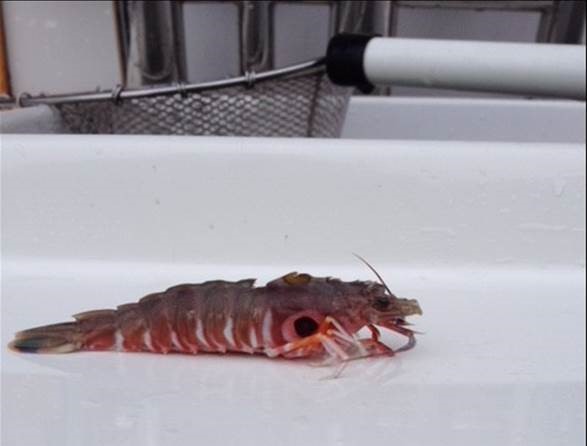
Can You Identify This Shrimp?

by CDFW
8-17-2018
Website
Question: In May of 2016, this shrimp drifted by our boat at night while we were fishing for squid on the south side of Catalina Island. I have been unable to identify it. Can you tell me what it is? (Kenny)
Answer: This is a target prawn (Sicyonia penicillata), also known as rock shrimp due to the rock-like hardness of the shell. They are commonly found along the Gulf of California and on the western coast of the Baja California peninsula. You may take any type of ocean shrimp in California waters. If you’re interested in learning how to fish for these interesting shellfish, please check out the crustaceans section of the current Ocean Sport Fishing regulations for the regulations, legal gear, limits and other information you will need to know (California Code of Regulations Title 14, sections 29.05, 29.10 and 29.80).
Help with Problem Geese
Question: My neighbors and I have a major problem with Canada geese. We live on a street that parallels an irrigation canal. Approximately 25 to 35 geese invade our yards every day, three to five times a day. They block the intersection and streets in all directions on their way, and they do a lot of damage to the grass and plants as well as inundate our yards, sidewalks and streets with feces. Do you have any suggestions on what we can do to control the problem? We also get mallards, but in much smaller numbers and they do far less damage. Is it possible to control the geese without scaring off the ducks? All we’ve managed to do is herd the geese from one yard to another, which is not a very good solution. (Bernie)
Answer: This is a very common human-wildlife conflict. Since it’s summertime, these are likely molting geese and they’re out searching for food along the canal. This time of year the grass dies back and the green grass they need becomes scarce, right when their normal need for food is multiplied due to the increased energy demand of re-growing feathers. Irrigated lawns and other landscaping plants are obvious attractants.
California Code of Regulations Title 14, section 251.1 forbids the harassment of animals (including birds), but makes an exception for landowners or tenants who are driving or herding birds or mammals for the purpose of preventing property damage. In this case, you might be able to install a temporary fence that would keep the geese out. Or you could contact the maintenance division of the agency that maintains the canal, as they may have a solution too. Other options include non-lethal methods of harassment such as dogs, laser pointers (green works best) and chasing them away so they are scared of humans.
CCR Title 14, section 503 speaks specifically to nuisance Canada geese, and the conditions under which you can obtain a permit to trap and relocate them.
Hunting with a companion dog
Question: I have a deer tag for X3B for 2018 season. My wife will come along with me, and since we have nobody to stay home to take care of the dog, we will need to bring the dog along for several days for our hunting trip too. We don’t use the dog for deer hunting. Is it legal to have a non-hunting dog with me on a deer hunting trip? (Minh)
Answer: Congratulations on drawing a tag for X3B! That’s a beautiful part of California. Yes, this is legal. Per the California Code of Regulations Title 14, section 265(c)(1), you are limited to one dog per licensed hunter during the general season only (sorry, no dogs are allowed during archery season!). Be aware, if you happen to have a bear or bobcat tag in your possession as well, Fish and Game Code, section 3960 prohibits you from having a dog at all. Good luck with your hunt.
Why do I need a license in international waters?
Question: Why does a United States citizen (a resident of California) need a fishing license to fish international waters off the California coast? (Anonymous)
Answer: California waters extend from the shore (high tide line) out to three nautical miles, federal waters stretch from three nautical miles to 200 nautical miles and international waters begin at 200 nautical miles out. All waters out to 200 nautical miles are still patrolled and managed cooperatively with the federal government. Any fish taken outside of 200 nautical miles must still meet all fishing regulations in order to be brought back into U.S. waters, and all fish landed at California ports must additionally meet all California regulations.
Fisheries in all state and federal waters have regulations and many have strict management guidelines to properly manage the take of various species to assure overfishing does not occur which could collapse those and related fisheries. Regulations and limitations of fishing activities and take is imperative, especially in waters of a state populated by nearly 40 million people.
Website Hosting and Design provided by TECK.net